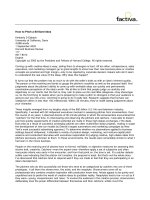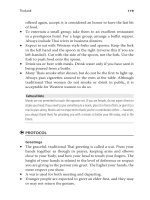Tài liệu HOW TO MEASURE THE IMPACT OF A CRM STRATEGY ON THE FIRM PERFORMANCE doc
Bạn đang xem bản rút gọn của tài liệu. Xem và tải ngay bản đầy đủ của tài liệu tại đây (144.02 KB, 15 trang )
HOW TO MEASURE THE IMPACT OF A CRM STRATEGY ON THE FIRM
PERFORMANCE
M. Rosa Llamas and M. Aránzazu Sulé
Área de Comercialización e Investigación de Mercados
Facultad de Ciencias Económicas y Empresariales
Universidad de León
Campus de Vegazana, s/n
24071 León (Spain)
M. Rosa Llamas e-mail:
Tl: +34 987 291455
Fax: +34 987 291454
M. Aránzazu Sulé e-mail:
Tl: +34 987 291000 Ext. 5451
Fax: 34 987 291454
1
HOW TO MEASURE THE IMPACT OF A CRM STRATEGY ON THE FIRM
PERFORMANCE
ABSTRACT
CRM strategy (Customer Relationship Management) is a business philosophy, stemming from
Relationship Marketing that joins strategy and technology, with the aim of creating value for
both customers and the company. In this paper we justify the interest of establishing a formal
system to measure CRM performance. In order to do that, we first focus on the role of
marketing performance measurement throughout the time. Then, we compare different
frameworks and metrics used to measure performance in the CRM era. Finally, challenges to
face in CRM performance measurement as well as some ideas for future research are discussed.
Keywords: CRM, marketing performance measurement.
1. INTRODUCTION
The importance of customer relationship management as source of competitive advantages has
been recognized for decades (McKenna, 1993; Woodcock, 2000), nevertheless, it has been in
recent years, with the deployment of the information technologies, when CRM has gained
growing popularity.
This business philosophy combines strategy and technology with the aim of get to know the
customer and establishing a two-way communication and interaction in order to improve the
efficiency and effectiveness of the business processes, increasing the value for both, customer
and company. There are three issues underlying the RM concept: relationships, networks and
interaction (Gummesson, 2002).
Srivastava, Shervani and Fahey (1999) in a special number of the Journal of Marketing entitled
“Fundamental issues and directions for marketing”, point out that the CRM is one of the three
key aspects in business processes since it lets the company identify consumers, create
knowledge, build relationships with customers and model their perceptions about the company
and its products. Brown (2000) considers that managing relationships with customers is
revolutionizing marketing and redefining business models. In this sense, Greenberg (2001, p. 6)
talking about CRM, states that we are on the verge of the most significant transformation in
business.
2
Although CRM concept has been the central core of many articles, conferences and seminars,
so far most of them corresponds to enterprise initiatives and there is a lack of empirical
academic research (Ang and Buttle, 2002; Kim, Suh and Hwang, 2003; Plakoyiannaki and
Tzokas, 2001; Winer, 2001).
The CRM approach is simple but its implementation is complex, for that reason, a high
percentage of CRM projects fails. In this sense, authors like Grabner-Kraeuter and Moedritscher
(2000) and Woodcock (2000) and consulting firms such as Gartner (2001) and Meta Group
(2002) maintain that defining project objectives clearly and having metrics that indicate the
degree of attainment of such objectives in a dynamic way, increases the likelihood of success of
such projects.
In fact, one of the research priorities in the CRM field is the development of metrics that enable
the managers to know to what extent CRM programs are working (Winer, 2001). The
Marketing Science Institute has also echoed this problem giving the topic “Assessing Marketing
Productivity (Return on Marketing) and Marketing Metrics” its highest priority for 2002-2004
(Marketing Science Institute, 2002).
Although most of the authors propose a phase of performance measurement (Payne, 2000;
Plakoyiannaki and Tzokas, 2001; Srivastava, Shervani and Fahey, 1999; Winer, 2001;
Woodcock, 2000), there is not an accepted academic model of measurement. The increasing
interest in developing measurements which justify investments in CRM includes financial and
non-financial measures, since the latter ones are receiving more and more importance (Clark
1999; IMA 1993; 1995; 1996; Marketing Science Institute 2002; Marketing Week, 2001;
Moorman and Rust, 1999; Shaw and Mazur 1997; Schultz, 2000).
The objective of this paper is to shed light on CRM performance measurement in order to foster
empirical academic research on this field, which has become of increasing interest for both
academics and managers. First of all, we focus on the business performance measurement,
placing a particular emphasis on marketing metrics. Next, we study the evolution of the
measures used in the marketing field and compare different frameworks and metrics used to
measure performance outcomes of a CRM strategy. Finally, we discuss the challenges to face in
CRM performance measurement as well as some ideas for future research.
2. MARKETING PERFORMANCE MEASUREMENT: FROM FINANCIAL METRICS TO
SCORE CARD METHODS
Business Performance Measurement (BPM) has a lot of branches in a wide variety of
disciplines, including accounting, economics, human resource management, marketing,
operations management, psychology and sociology. In the field of marketing, performance
measurement has not been developed all that much. In fact, it has been the target of criticisms
due to its short term orientation (Dekimpe and Haussens, 1995, 1999), its limited diagnostic
power (Day and Wensley, 1988), the lack of consensus in relation to the number of measures
and the subsequent difficulty for making comparisons (Clark, 1999; Ambler and Kokkinaki,
1997).
The reasons for this poor development of marketing accountability are the difficulties in
measurement which involves the assessment of the results derived from the implementation of
different marketing strategies. One of these barriers is the complexity to isolate the effects of a
3
particular marketing strategy (Bonoma and Clark, 1998). Another one, is that those effects are
perceived, in most of the cases, in the long term (Dekimpe and Hanssens, 1995).
Nevertheless, it is very useful and neccessary to measure performance in order to evaluate the
result of the different marketing strategies. It lets reinforce those with positive results and
correct others not providing the expected benefits. Furthermore, it is said that what gets
measured, gets managed. According to Metrus Group (2003) there is considerable evidence of
strategic performance measurement on strategy execution and strategic performance. This
company carried out a study about the benefits of strategic performance measurement, finding
six reasons why strategic performance measurement is so powerful in improving business
performance: (1) measurement rapidly forges increased strategic agreement; (2) measurement
provides a common language to communicate strategy and key values; (3) measurement helps
forge alignment throughout the organization; (4) measurement accelerates the rate of successful
change; (5) measurement increases a company’s predictive power and early warning capability;
(6) measurement helps provide managers with a holistic perspective.
In recent decades we are being witnesses of an important transition from an industrial society to
an information one. According to many authors, this transformation, fostered by information
revolution, is comparable to previous revolutions because of the important economic and social
effects derived from it.
This revolution involves the reformulation of the key resources for the companies. If in the
Industrial Revolution the emphasis was on the tangible assets such as equipment, raw materials,
human resources, energy, etc., in the Digital Revolution intangible resources such as brand
image, customer loyalty, market knowledge, know-how, etc. are the stars.
Nowadays, it is clear that the core of the resources on which the management lies in and whose
efficient combination is translated into benefits, has broadened including another kind of issues
under the umbrella of “intangible”, “intellectual” or “invisible”. These assets can provide the
company with an important competitive advantage, guiding its success.
This change in the focus regarding to the importance of productive resources has been followed
by an evolution in the business performance measurement orientation. Traditionally marketing
performance measurement was based on the information provided by Accounting Department,
derived from balance sheet and income statement. Those measurement systems only had into
account tangible measures such as sales, gross margin, percent value from new products and
services (Crosby and Johnson, 2001). In the 80s market share gained great popularity as a
strong predictor of cash flow and profitability (e.g. Buzzel and Gale, 1987).
During the 90s, customers are viewed as assets (Rust, Zeithaml and Lemon, 2000) or equity of
the firm (Blattberg and Deighton, 1996; Blattberg and Thomas, 2001; Rust, Zeithaml and
Lemon, 2000). This customer-centered viewpoint is reflected in the concepts and metrics that
drive marketing management, so a measurement literature arises (Berger and Nasr, 1998;
Gupta, Lehmann and Stuart, 2002; Jain and Singh, 2002; Mulhern, 1999; Reinartz and Kumar,
2000; Rust, Lemon and Zeithaml, 2003). Furthermore, the relationship between non-financial
measures such as customer satisfaction (e.g. Anderson, Fornell and Lehmann, 1994; Ittner and
Larcker, 1998b; Szymaski and Henard, 2001), customer loyalty (Dick and Basu, 1994), brand
equity (Keller, 1998), employee equity (Amir and Lev, 1996; Srivastava, Shervani and Fahey,
1998) and profitability was proved, and subsequently this type of measures started to have a
great deployment.
4
Nowadays the increasing dynamic and competitive business environment demands holistic
measurement systems which provide the company with a complete “map” of different aspects
influencing the results of companies, in order to neutralize their weaknesses, reinforce the
strengthens and create new ones. In a CRM world, companies have a great amount of data
which can be transformed into useful information by easing strategic management and control
process. Managing this information in a systematic and dynamic way can yield a competitive
advantage.
According to Ambler, Kokkinaki and Puntoni (2002) the evolution of marketing metrics seems
to fit the following pattern:
- Little awareness regarding the necessity of using marketing metrics at top executive
level.
- Measurement systems based exclusively on financial metrics.
- Broad vision of performance measurement including non-financial metrics.
- Seeking some rationale(s) to reduce the number of metrics, about 25 or less (Unilever,
1998).
Performance measurement metrics can be classified into different categories: financial versus
non-financial; one-dimensional versus multi-criteria (Grabner-Kraeuter and Moedritscher,
2002); input, management and output measures (Clark, 1999); hard versus soft (Ang and Buttle,
2002); tangible versus intangible.
One of the most used classifications divides success measures in two broad categories: financial
and non-financial (Buckley, Hall, Benson and Buckley, 1988; Frazier and Howell, 1982). Early
research in performance marketing measurement focused on financial indicators: profit, sales
and cash flow (Day and Fahey, 1988; Sevin, 1965). Recently, the non-financial measures are
receiving more and more attention. Grabner-Kraeuter and Moedritscher (2002) point out that
the inclusion of this type of measures has become the state-of-the-art in managerial accounting
and business performance measurement research. Some years before, Kaplan and Norton
(1996) pointed out that non-financial measures are a great tool providing support to the top
executives to identify potential problems and assess the success of the company. An increasing
number of authors agree with them indicating the importance of soft measures (Clark 1999;
IMA 1993; 1995; 1996; Marketing Science Institute 2002; Marketing Week, 2001; Moorman
and Rust, 1999; Schultz, 2000; Shaw and Mazur 1997).
We can wonder if the popularity of non-financial measures from an academic point of view is
accompanied by the same success from a managerial perspective. There are a few researchers
who have analysed the extent to which financial and non-financial measures are used by
practitioners. A recent study from Reinecke and Reibstein (2002) found that managers primarily
rely on quantitative performance metrics such as sales, market coverage, margin, net profit,
sales profitability, share of new customers, etc. but they increasingly include qualitative
indicators such as customer satisfaction, customer retention or brand familiarity. These findings
confirm the results of another research carried out by Ambler, Kokkinaki and Puntoni (2002) in
the United Kingdom. This study shows that top management considers financial measures more
important than any other category, so this kind of metrics are the most frequently collected. The
indicators enjoying the major popularity among the top management are the following:
profit/profitability; sales, value and/or volume; gross margin; awareness, market share (volume
or value); number of new products; relative price (SOMValue/volume); number of consumer
5
complaints (level of dissatisfaction); consumer satisfaction; distribution/availability; total
number of customers; marketing spend; perceived quality/esteem; loyalty/retention; relative
perceived quality.
In spite of academics think that non-financial metrics should leader performance measurement,
practitioners remain using predominantly classical ones. We can find the explanation for this
behaviour in the fact that these indicators are much easier to measure. In addition, conventional
methods have the advantage of being investment evaluation settings. Their major drawback of
evaluation is that they focus on the estimation of cash flows and accounting criteria (Kim, Suh
and Hwang, 2003). Nevertheless, traditional performance systems do not provide a full
understanding of the influences on profits. The major criticisms to classical metrics are
summarized in the following:
- Accounting metrics have a focus on the short-term and take little account of the value to
the firm of long-term customer preference, or the marketing investment which created it
(e.g. Ambler, Kokkinaki and Puntoni, 2002).
- They are not adequate for assessing investments whose benefits will be intangible,
indirect or strategic (e.g. Bukowitz and Petrash, 1997; Grembergen and Amelinckx,
2002).
- They only report functional processes (e.g. Ittner and Larcker, 1998a).
- They do not take into account the influence of marketing decisions on such variables as
inventory levels, working capital needs, and financing costs that need to be managed for
the well-being of the enterprise (e.g. Srivastava, 2004).
- They do not let aggregation from an operational level to a strategic one They just look
backwards, recording historical data so their prediction power is limited (e.g.
Chakravarthy, 1986; Ittner and Larcker, 1998a; Yeniyurt, 2003).
- They are not suitable for strategic decisions (e.g. Kaplan and Norton, 1992).
- The do not measure the value created (e.g. Lehn and Makhija, 1996).
- They provide little information on deviations (e.g. Ittner and Larcker, 1998a).
- There is a high number of metrics, so researchers should find some convergence in
order to describe more with less numbers (e.g. Frigo and Krumwiede, 2000; Kaplan and
Norton, 1992).
- They do not link the non-financial metrics to financial numbers (e.g. Kaplan and
Norton, 1992).
Traditionally financial and non-financial measures have been seen as opposed, but there are
many connections between these two kinds of metrics. Jutla, Craig and Bodorik (2001) state
that some metrics are function of other metrics. The results of some studies about the lead/lag
relationship between financial and non-financial metrics show that there is a strong association
between non-financial performance measures such as customer and employee satisfaction,
customer and employee retention and quality measures and financial indicators such as
profitability (Banker and Mashruwala, 2000, Banker, Potter and Srinivasan, 2001; Ittner and
Larcker 1998a and 1998b, Nagar and Rajan, 2001).
3. PERFORMANCE MEASUREMENT IN THE CRM ERA
6









